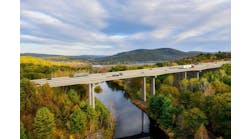What is RCC?
RCC is a stiff, zero-slump concrete mixture with the consistency of damp gravel comprised of local aggregates, portland cement and water. The mixture is placed and roller compacted with the same commonly available equipment used for asphalt pavement construction. The process requires no forms, finishing, surface texturing or joint sawing and sealing.
RCC has low water content, requiring it to be mixed in a continuous flow system, usually a pugmill, instead of a ready-mixed truck. A dump truck transports freshly mixed RCC to the construction site where workers place the mixture in layers, called lifts, using a conventional asphalt spreader. Lifts, which range from 8 to 12 in. in thickness, are then compacted using vibratory steel-wheel and pneumatic-tire rollers. Immediately after workers complete compaction, water is applied as a fine mist to cure the concrete.
Because of its low water-cement ratio, RCC typically has high strengths similar to, or even greater than, conventional concrete. RCC's high-strength properties combined with ease of construction and high rate of production make RCC an alternative to flexible pavement. Additionally, more than 20 years of exposure as logging roads in cold climates have demonstrated that RCC has adequate resistance to freezing and thawing.
Intersection repair
The first RCC/asphalt inlay intersection rehab project was performed in 1993 in Edmonton, Canada. Standard General of Birmingham, Ala., an RCC contractor, performed the 840-sq-yd project.
This year, Edmonton, will pave about 31,900 sq yd using about 20,000 cu yd of RCC. More than eight Canadian cities now use RCC and asphalt inlays for intersections.
Typically, intersections are paved using 8 in. of RCC and 2 in. of asphalt. The RCC material boasts a strong 4,000 psi.
It is useful on intersections that have heavy traffic loads or those susceptible to rutting. Crews mill out about 10 in. of existing asphalt traffic lanes to begin the process. With this rehab technique, it is necessary only to replace the traffic lanes, not the curb and gutter. Also the length of each lane replaced varies, depending on the ruts in the roadway. The longer they are, the longer the RCC pavement.
Crews mill about 8 in. of asphalt out during the week using ramps, barricades and flaggers to keep traffic flowing through the intersection, according to Tim McLaughlin of Standard General. On Friday night, the city closes half the intersection. Crews remove the remaining 2 in. of asphalt overnight.
Each side of an intersection is usually about 3,200 sq ft. "We come in Saturday morning at 7 a.m. and put the RCC down," says McLaughlin. "That takes until 1 p.m."
Once the RCC is placed, crews spray on a tack coat of asphalt emulsion. "Then we change the trucks from the RCC plant to the asphalt plant," says McLaughlin. "We have an asphalt paver on site, so the same crew places both products."
By 4 p.m., the 2-in. asphalt layer is down. It cools until about 7 p.m. when the road reopens to traffic on the rehabilitated side. "Then they switch the barricades and let traffic on the road," says McLaughlin. "Starting Saturday night, we repeat the same process on the other side."
By about 7 or 8 p.m. Sunday, traffic is flowing normally. A 6,400-sq-ft intersection rehab is completed in one weekend.
"This is useful especially in industrial areas where you have a lot of people coming on weekday mornings," says McLaughlin. "A lot of municipalities look at it because they can have a 4,000-psi product in and traffic flowing again in 24 hours."
McLaughlin says another advantage to RCC inlays is that cities don't have to rehab the entire intersection; they can stop at the driving lanes. Also, once complete, the pavement is maintained the same way as regular asphalt pavement.
This process has caught on in Canada. The cities of Fort McMurray, Fort St. John, Edmonton, Calgary, and Regina have used RCC pavement to rehab intersections.
RCC also is emerging as a cost-effective, high-performance base for conventional highway and street pavements. A thin layer of asphalt normally covers the surface to ensure a smooth ride at street and highway speeds. In Edmonton, Canada, the city paved a two-lane, 1,800-ft stretch of a street with 8 in. of RCC over a 6-in. cement-stabilized subgrade to carry increased loads from heavy trucks accessing a new waste processing facility.
Other Advantages
RCC pavements have other advantages that helped make them an attractive option to city officials and planners. RCC will not rut from high axle loads or shove or tear from turning or braking.
It will not soften from heat generated by composting or hot summer sun. RCC resists degradation from materials such as diesel fuel. RCC pavements also help yield the highest quality compost because they can withstand high temperatures generated by natural composting while minimizing contamination sources.


